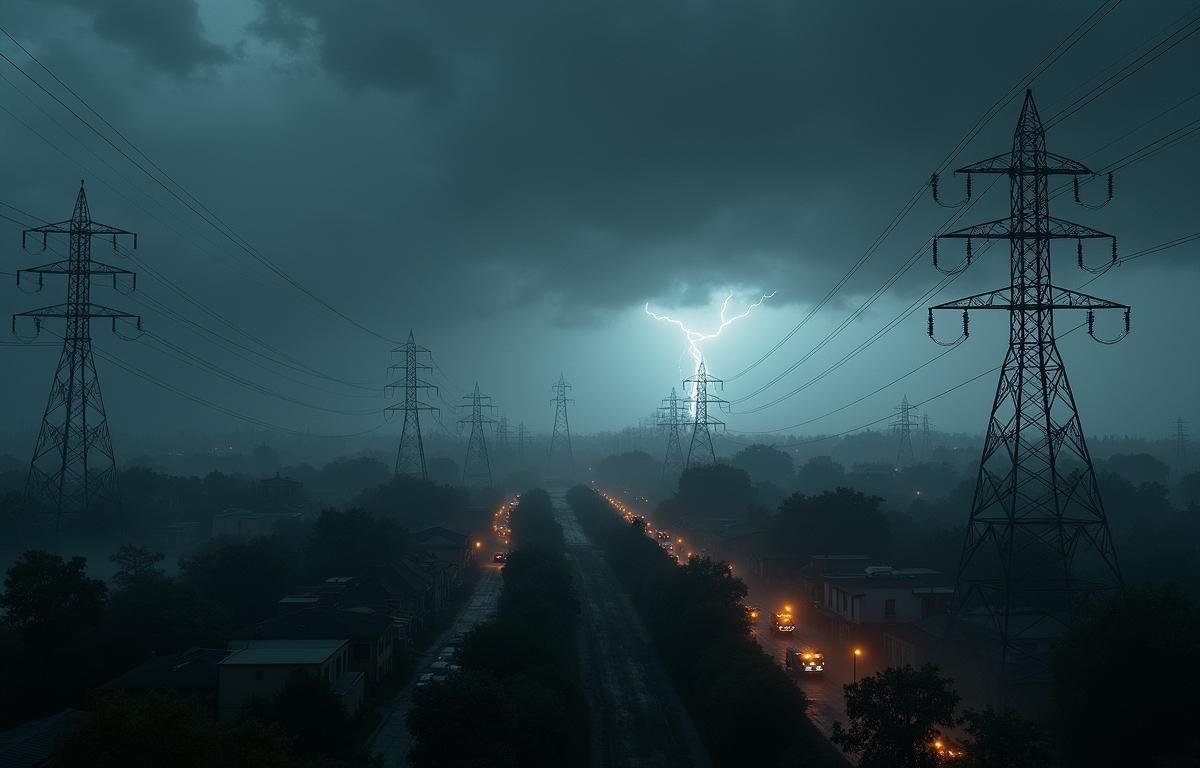Power failures on a large scale can disrupt regions and affect daily activities. Homes go dark, businesses halt operations, and hospitals scramble for backup systems. Even though electricity feels like an everyday convenience, there is real complexity behind generating and distributing power. When that chain snaps, cascading effects can sweep through entire continents.
Contents
The Role of Grid Complexity in Blackouts
Power grids are intricate webs of hardware and software that span continents. They carry electricity from power plants to consumers through thousands of miles of cables. If even a single major subsystem fails at a critical location, problems can escalate quickly. This intricate design allows us to power large cities but also leaves room for vulnerabilities when one point encounters trouble.
One core challenge lies in keeping supply and demand balanced at every second. When demand suddenly spikes, generators must quickly adjust to deliver enough electricity. If generators or grid control systems lag behind, the mismatch can lead to voltage drops or excessive currents, paving the way for a potential blackout. That tightrope act of balance makes grid complexity both a marvel and a headache.
Transmission Lines and Potential Failures
High-voltage transmission lines are the arteries of our electrical infrastructure. They carry electricity across vast distances, but they are incredibly sensitive to fluctuations. Heavy loads beyond their rated capacity cause lines to sag, and extreme heat can even increase resistance in the conductors. Overburdened lines strain the power distribution puzzle and raise the risk of large-scale interruption.
Heat is not the only enemy. Lines can snap or short-circuit during severe storms, setting off chain reactions. If one line stops working, the adjacent lines must pick up extra load. That hustle can push them beyond safe thresholds, leading to more failures. Soon, multiple lines go down, and entire sections of the network lose power.
Weather Patterns Trigger Widespread Outages
Mother Nature exerts a major influence on grid reliability. Hurricanes, blizzards, and heatwaves impose enormous stress on power systems. Fierce winds can knock down utility poles, and heavy ice can snap branches that destroy overhead lines. Power plants also struggle when extreme cold disrupts their cooling systems or when scorching temperatures affect machinery.
One dramatic example emerges with hurricanes. Flooded substations short out, and debris tangles overhead wires. Meanwhile, emergency crews face treacherous conditions, delaying repairs. The longer a restoration effort takes, the more severe the ripple effect on local infrastructure. Areas left without electricity for extended periods contend with refrigeration issues, communication blackouts, and a slowdown in healthcare services.
Lightning, Wind, and Vulnerabilities
Lightning strikes may seem like momentary flashes, but they can unleash significant damage. When a bolt hits a poorly protected section of the grid, switches and transformers can burn out. Wind gusts during a storm can exacerbate hazards by throwing tree limbs against power lines. That rapid onslaught of weather factors creates prime conditions for initiating large-scale power failures.
Modern grids combat these threats with extensive grounding and surge protection systems. However, nature’s fury can overwhelm even robust protective measures. The complex relationship between grid hardware and weather underscores an inescapable fact: no network is immune from extreme storms.
Human Errors and Aging Infrastructure
While natural events pose significant threats, human decisions often nudge a fragile system off balance. Maintenance schedules might fall behind, and control centers can experience software glitches. Operators sometimes misjudge supply needs and inadvertently trip circuit breakers. Such mistakes create domino effects, underscoring how even small errors can amplify into large consequences.
Aging infrastructure also contributes to unnecessary risks. Transformers designed decades ago may operate past their recommended lifespans, exposing them to breakdowns during peak demand. Outdated protective devices can scramble signals and cut the wrong circuits. Add in an inadequate modernization budget, and the stage is set for abrupt failures on a vast scale.
Maintenance and Upgrades
Regular inspections and fast upgrades help keep the power grid operating. However, large networks require significant labor and resources to maintain. Transmission lines need structural assessments, and substations require calibration checks. When maintenance teams postpone these tasks, vulnerabilities grow.
Upgrades present their own challenges. Phasing in new equipment while keeping the system online can be risky. A single software glitch in a control system might cause unintended shutdowns or power surges. Coordination across multiple locations demands rigorous testing. Despite these hurdles, proactive modernization stands as one of the few surefire ways to curb the likelihood of blackouts.
Chain Reactions Within the Electrical Grid
One of the most striking elements of large-scale power failures is their snowball nature. A malfunction in one region can place immense pressure on neighboring areas, triggering a domino effect. Circuits that overheat begin to trip, shifting the burden of power delivery to adjacent lines. In minutes, entire cities lose electricity, leaving no quick fixes.
That chain reaction can move alarmingly fast. Sudden grid collapse can confuse operators who rely on real-time data to manage power flows. Quick decisions become critical: a delayed response can widen the outage. The science behind these failures illustrates that protective systems can only do so much when events escalate exponentially.
Simulations and Predictive Models
Energy researchers use computer simulations to model potential chain reactions. They feed real grid data into programs that emulate different failure scenarios. Predictive models look for hotspots, lines running close to capacity, and regions prone to frequent storms. Though these simulations help system operators anticipate trouble, real-life conditions are always changing.
Nonetheless, advanced tools offer valuable insights to plan ahead. Teams can analyze how a failed generator in one part of the grid affects transmission lines elsewhere. This foresight enables operators to brace for high demand periods or intensify monitoring before severe weather strikes. By spotting weak links early, utilities try to stop small disruptions from spiraling into blackouts.
The Global Impact of Massive Blackouts
When an entire region goes dark, the economic impact is substantial. Factories cease production, airports cancel flights, and data centers operate on borrowed time. Industries depending on electricity to keep their inventories chilled or their machinery running can lose significant revenue with each hour offline.
Beyond business, everyday life suffers too. Homes with no power struggle to store perishable foods, and communication networks can shut down. Critical services like water treatment facilities might rely on backup power, but those generators only last for so long. Prolonged outages can erode public safety when streetlights and security systems fail to function, intensifying anxiety in the community.
Ripple Effects on Essential Services
Hospitals usually have emergency generators, but these systems rely on consistent fuel supplies and correct maintenance. If a major fuel shortage coincides with a widespread outage, patient care becomes jeopardized. Public transit networks that rely on electrical infrastructure grind to a halt. In large metropolitan areas, that disruption can paralyze commuter movement.
International trade is also vulnerable. Ports with idle cranes cannot load or unload ships on schedule. Digital communication may remain intact if satellite and cellular towers have backup power. Still, an outage that extends for days or weeks can undermine critical internet hubs. That scenario disrupts everything from banking to air traffic control, rippling through global markets.
Possible Strategies for Improving Grid Reliability
Forward-looking utilities experiment with new innovations to reduce outages. Microgrids, for instance, can isolate smaller sections of the network. By operating independently when the main grid experiences trouble, microgrids keep electricity flowing to essential services. This localized approach aims to reduce massive cascading events.
Researchers also investigate energy storage solutions, such as large-scale batteries, to buffer imbalances. When power usage spikes, these batteries discharge to stabilize the grid. The rise of renewables like solar or wind further complicates power management, but advanced forecasting methods help grid operators plan around weather fluctuations.
Role of Advanced Technology
Smart sensors can track critical parameters throughout the system. If abnormal vibrations or temperature increases appear in a transformer, operators receive immediate alerts. Swift preventive action can halt a malfunction before it spreads. Real-time data improves the chance of catching problems in their infancy and keeping power stable.
Artificial intelligence tools also promise more precise control over generation and distribution. Algorithms can interpret huge datasets to make split-second adjustments. However, these high-tech solutions demand constant oversight. Software bugs can be as dangerous as hardware failures, especially if entire networks depend on automated decision-making.
Balancing Future Growth With Safety
Demand for electricity surges as populations grow and new technologies emerge. Data centers supporting cloud services devour enormous amounts of power. Electric vehicles add extra load to local lines and transformers. To keep pace, utilities need robust expansion plans that factor in resilience and reliability.
Navigating these challenges involves tough choices about investment in modern infrastructure. Governments and energy providers debate how to split costs between ratepayers and stakeholders. Delays in planning can magnify risks when old equipment struggles to meet modern demands. Although perfection is impossible, prioritizing strong maintenance protocols and advanced monitoring helps reduce the likelihood of large-scale blackouts.
Ensuring grid resilience is an ongoing effort that blends science, engineering, and strategic policy. With careful planning and investment, communities can mitigate the worst impacts and keep essential services powered. Yet the puzzle remains: as long as grids stretch across continents and contend with countless variables, large-scale power failures will remain an ever-present risk.



